Profiling of gene fusion involving targetable genes in Chinese gastric cancer
lNTRODUCTlON
Gastric cancer (GC) is the fifth most frequent cancer and the third leading cause of cancer deaths worldwide,with more than one million new cases and approximately 769000 deaths in 2020[1].The overall survival rate of patients with early stage disease is around 90% after surgical resection[2];however,more than 80% of patients with GC are diagnosed at an advanced stage in China,which limits the effectiveness of the treatment[3].Although chemotherapy has improved the survival of advancedstage patients with GC,the objective response rate remains less than 40%,and the median overall survival is less than 12 mo[4].Nevertheless,new targeted therapies are capable of improving the objective response rate and overall survival of patients with GC expressing certain targets[5].
Approximately 13%-22% of GCs exhibit
overexpression or amplification[6-8].The College of American Pathologists,the American Society for Clinical Pathology,and the American Society of Clinical Oncology recommend that all patients with advanced gastric adenocarcinoma should be tested for
overexpression[9].Trastuzumab was approved by the United States Food and Drug Administration (FDA) in 2010 as first-line treatment in combination with chemotherapy for patients with
-positive GC.Microsatellite instability-high (MSI-H) tumors are considered a molecular subtype of gastric adenocarcinoma by The Cancer Genome Atlas (TCGA)[10].The incidence of MSI-H GC is 10%-20%[11].The NCCN guidelines recommend MSI testing as a standard test for all patients with GC.Regarding targeted therapy,the FDA has approved pembrolizumab (
monoclonal antibody) for the treatment of all unresectable or metastatic solid tumors with MSI-H/dMMR (deficient DNA mismatch repair),including GC.Although drug treatments have shown success to some extent,the development of more targeted drugs is required.
I must make one effort to go, said Anne Lisbeth, to see mydarling, the count s sweet child, and press him to my heart. Certainlyhe must long to see me, too, the young count; no doubt he thinks of me and loves me, as in those days when he would fling his angel-armsround my neck, and lisp Anne Liz. It was music to my ears. Yes, Imust make an effort to see him again. She drove across the country in a grazier s cart, and then got out, and continued her journey on foot, and thus reached the count s castle. It was as great and magnificent as it had always been, and the garden looked the same as ever; all the servants were strangers to her, not one of them knew Anne Lisbeth, nor of what consequence she had once been there; but she felt sure the countess would soon let them know it, and her darling boy, too: how she longed to see him!
With rapid advancements in the field of oncogenomics,gene fusions in cancer have received increasing attention.The FDA has approved larotrectinib (Vitrakvi) and entrectinib (Rozlytrek) for the first- or subsequent-line treatment of solid tumors with
fusions,including GC[12,13].In 2021,the FDA accelerated the approval of the
inhibitor,zenocutuzumab (MCLA-128),in patients with pancancer harboring an
fusion.Apart from these fusion genes with approved drugs in pan-cancer,
fusions,such as
,
and
have been identified in the majority of tumors,including lung adenocarcinoma and colorectal cancer[14-16].For lung cancer and mesenchymal tumors,patients harboring an
fusion are highly responsive to crizotinib and ceritinib[17,18].Recently,a
fusion was identified in a patient with GC[19],which indicates the possibility of future applications of
-TKIs (tyrosine kinase inhibitors) in these patients.Recent advances in nextgeneration sequencing (NGS) have contributed to a surge in the discovery of fusion genes,including
;
;
,
,and
;
; and
[20].Gene fusion detection can guide the development of targeted therapeutic strategies for patients with GC with disease progression after standard therapy.Notably,there is a lack of comprehensive data characterizing gene fusions involving targetable genes in GC,particularly in the Chinese population.
The statue of the Grimms Musicians is on the west side of the Rathaus (Bremen Tourism, Bremen ). The statue is by Gerhard Marcks and was done in 1951 (Bremen Tourism, Bremen ). There is also a Gerhard Marcks house/museum in the city.
After wandering about for several days until he was weary and hungry, he at last succeeded in finding a way out of the forest, and soon came to a wide and rapid river, which he followed, hoping to find some means of crossing it, and it happened that as the sun rose the next morning he saw something of a dazzling whiteness moored76 out in the middle of the stream
MATERlALS AND METHODS
Patients
The study was reviewed and approved by the Fujian Provincial Hospital,Institutional Review Board (Approval No.K2022-03-101).
Mutational profiling
Gene fusions involving targetable genes were characterized in Chinese patients with GC.Testing gene fusions may provide insight for the treatment of GC.
Then one day, something changed. Not in Sprite, but in me. It happened one distressingly15 hot, summer day when I had retreated to the relative coolness of my home. Not knowing what to do with the hours stretching out before me until the sun disappeared behind the horizon, giving relief to blistering16 air, I perused17 one book, and then another, of old and yellowing pictures.
The frequency of fusion events involving the abovementioned 10 targetable genes in the TCGA GC cohort and another Chinese GC cohort (OrigiMed2020 cohort) were analyzed and compared with our patient data (Figure 2B).Neither our cohort nor the OrigiMed2020 cohort showed significant differences in the incidence of these gene fusions in Chinese patients.In two Chinese cohorts,
fusions occurred less frequently.Fusions in
,
,
,
,and
were only identified in two Chinese cohorts; however,the differences in the incidence of these genes were not statistically significant.
Fluorescence in situ hybridization
FFPE tissue sections (5 μm) were prepared on positively charged slides.After deparaffinizing and rehydrating,the slides were incubated with prewarmed 8% sodium thiocyanate in dH
O at 80 °C and incubated for 30 min.
(10q26) or
(7q34) break-apart probes were placed on the slide,covered with a glass coverslip,and sealed with rubber cement.Hybridization was performed overnight at 37 °C.The slides were washed twice in 50% formamide at 47 °C for 2 min and then twice in 2X standard saline citrate at room temperature for 2 min.Nuclei were stained with DAPI as a counterstain.The slides were scanned using a 90i Nikon fluorescent microscope.For each probe,200 nuclei were evaluated.The 5′ (red) and 3′ (green) signals separated by ≥ 2 signal diameters were considered split as positive.
Statistical analysis
All statistical analyses were performed using SPSS 24.0 software (IBM,Chicago,IL,United States).
or Fisher’s exact test was used to analyze the association between fusion alterations and driver mutations.A
value of < 0.05 was considered statistically significant.
RESULTS
Clinical characteristics of patients
We retrospectively analyzed 1341 Chinese patients with GC who underwent genetic analysis from multiple centers in China.Of these,387 patients were excluded because gene fusion detection was not performed with the Onco PanScan panel using tumor tissue samples (Figure 1).Gene fusion events were detected in 20 patients; however,4 patients without any gene fusions involving targetable genes were excluded.Finally,16 patients with 20 fusion events involving targetable genes were included for further analysis.The clinical characteristics of 954 patients with GC are shown in Table 1.Of these patients,310 (32.56%) were women and 644 (67.44%) were men,with a median age of 57 and 62,respectively,at diagnosis.There was no significant difference between targetable gene fusion-positive and -negative patients in age (
= 0.293),sex (
= 0.463),MSI status (
= 0.551),or TMB (
= 0.217)(Table 1).
The landscape of gene fusions involving targetable genes in Chinese patients with GC
To gain insight into fusion events in GC,we evaluated 954 patients with GC undergoing gene fusion analysis.In total,20 patients harbored 24 gene fusions,2 patients had double fusions (patient 01 and 02),and 1 patient (09) harbored triple fusions.
fusions (5/24,17.8%) and
family gene fusions(5/24,17.8%) occurred most frequently in the cohort,followed by
(3/24,10.7%) and
(2/24,8.3%) (Figure 2A).
,
,
,
,and
fusions were identified in one patient each.Remarkably,20 of 24 (83.3%) fusions involved targetable genes (Table 2).
has been frequently reported as a 3′ fusion partner in acute promyelocytic leukemia[22].
was identified as a 5′ fusion partner in 4 patients and as a 3′ fusion partner in 1 patient; however,only the
fusion was detected in patient 01 as the 3′ fusion partner including exons 3-9,which encodes a DNA-binding and a ligand-binding domain required for
transcription factor activity[22].Three
fusions were identified in patient 09 as the 3′ fusion partner containing the complete tyrosine kinase domain,which was coded by exons 11-18.All
and
fusions were detected as 5′ fusion partners.Four
fusions were consistent with other known activating
fusions[23],which frequently occur with a breakpoint after exon 17 at the 3′ end of
with a 3′ fusion partner.The kinase domain was retained in these fusion genes.In patient 10,the
fusion involved the 5′ end of
exon 7,thus retaining an intact
kinase domain.
TMB was calculated using the total number of nonsynonymous mutations divided by the total genomic target region (2.13 Mb).MSI status was determined using MSIsensor from paired tumornormal targeted sequence data,and 309 MSI sites were included in the panel of 825 cancer-related genes.An MSIsensor score below 10 defines microsatellite stability (MSS) status,while that above 50 defines MSI status.The prevalence of gene fusions involving a targetable gene and driver mutations was compared with the OrigiMed2020 and TCGA cohorts[21].Clinicopathological and genomic data were retrieved from the cBioPortal (https://www.cbioportal.org).
The eel-breeder was a witty fellow, a merry guest, and brought ameasure of brandy with him. They all received a small glassful or acupful if there were not enough glasses; even Jurgen had about athimbleful, that he might digest the fat eel, as the eel-breeder said;he always told one story over and over again, and if his hearerslaughed he would immediately repeat it to them. Jurgen while still aboy, and also when he was older, used phrases from the eel-breeder sstory on various occasions, so it will be as well for us to listento it. It runs thus:
Novel fusions involving targetable genes in GC
In total,2 of 20 fusions involving the targetable genes,
and
,were reported in other cancers,including non-small-cell lung cancer[24-26].The remaining 18 gene fusions were not reported in any cancer types.In total,13 of 18 novel gene fusions contained the exon encoding a tyrosinekinase domain,such as exons 11-17 of
,exons 11-18 of
,exons 12-19 of
and exons 16-21 of
(Figure 3).All fusions involving
,
,
,and
retained the kinase domain (Table 2).Furthermore,reads in Integrative Genomics Viewer plots supported these gene fusions.To verify these novel fusions,fluorescence in situ hybridization (FISH) was performed using break-apart probes.Because only two tumor tissue samples were available,only the
and
arrangement in patient 04 and 09,respectively,were confirmed by FISH.
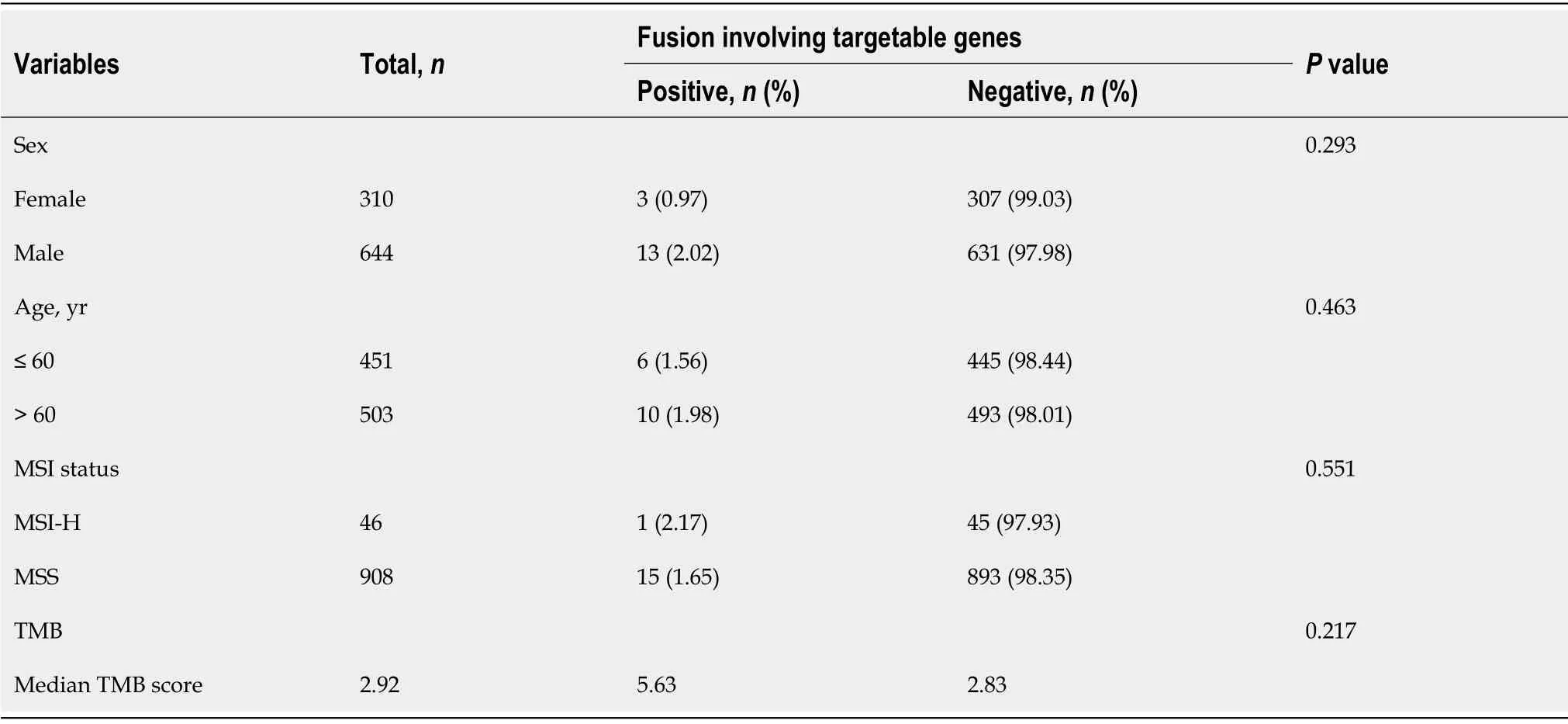
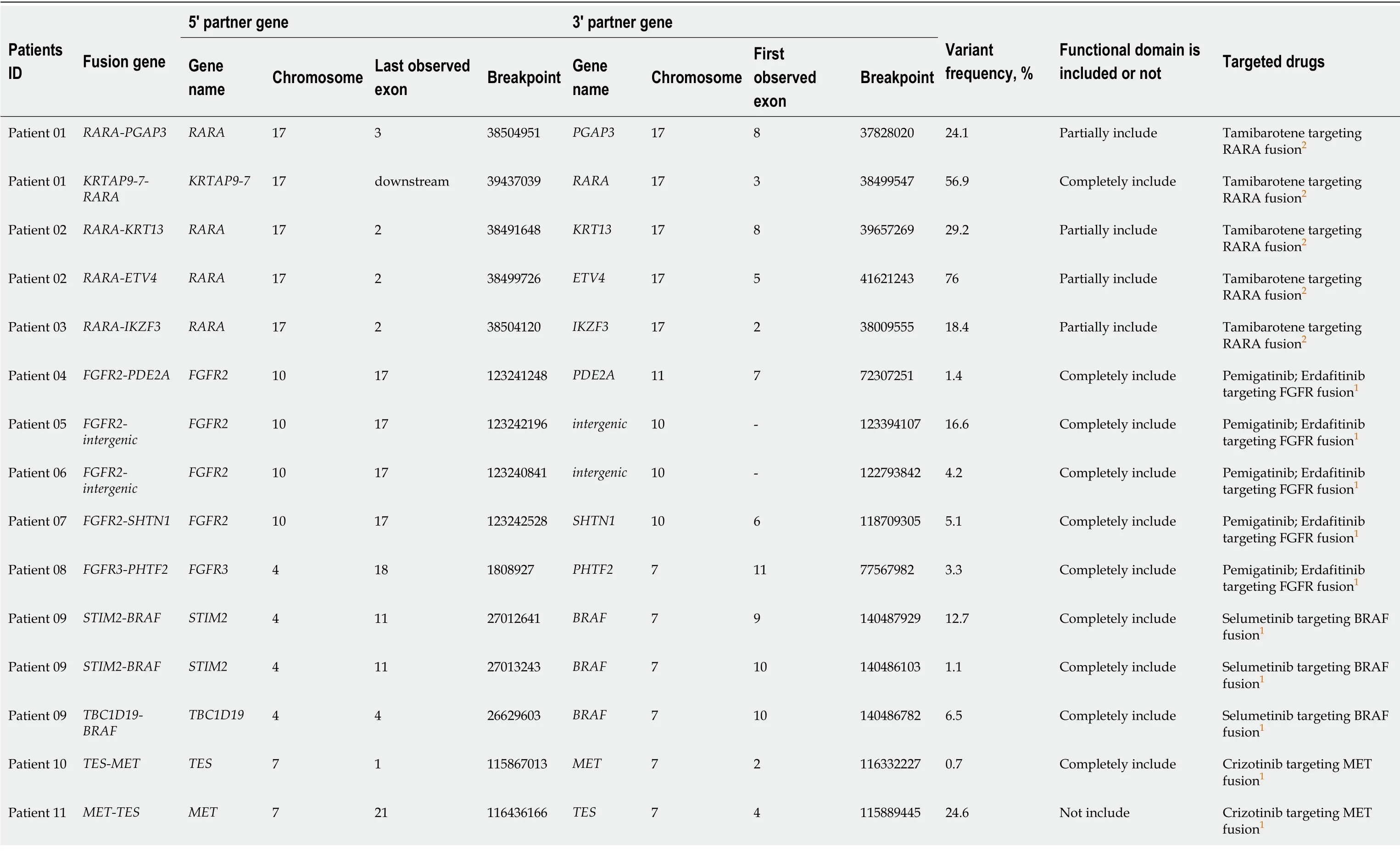

Gene fusions are enriched in patients with ERBB2 amplification but not in those with high MSI and TMB
Because of the low frequency of gene fusions in patients with GC,we determined whether gene fusions are enriched in different molecular subtypes of GC,which may indicate the patients that could benefit from gene fusion detection.Fusions are mutually exclusive with other oncogenic mutations and are enriched in patients without driver mutations[27-29].In our cohort,the frequency of genetic alterations in oncogenic driver genes of GC,such as
,
,
,and
mutations and
amplification,were comparable with those in the TCGA cohort (Supplementary Figure 1).There was no significant difference in the frequency of fusions involving targetable genes between patients with any alterations in all five driver genes and those without (Figure 4A).Notably,the fusion alteration frequency was significantly higher in patients with
amplification than in those without
amplification (Figure 4B,
= 0.01).To determine whether fusion alterations were enriched in other driver genes,
,
,
,and
were analyzed.There was no enrichment in fusion alterations for these genes (Supplementary Figure 2).Forty-six patients had the MSI-H phenotype.Of these,one patient with fusion genes exhibited MSI-H.There was no obvious difference in the incidence of gene fusions between patients with MSI-H and MSS (Figure 4C).Similarly,TMB scores were evaluated in targetable gene fusion-positive and -negative patients,but the results were not statistically significant (Figure 4D).
8.Horse: Horses are intelligent, strong animals highly valued and sometimes worshipped in numerous cultures. Horses are often considered lucky in folklore.Return to place in story.#p#
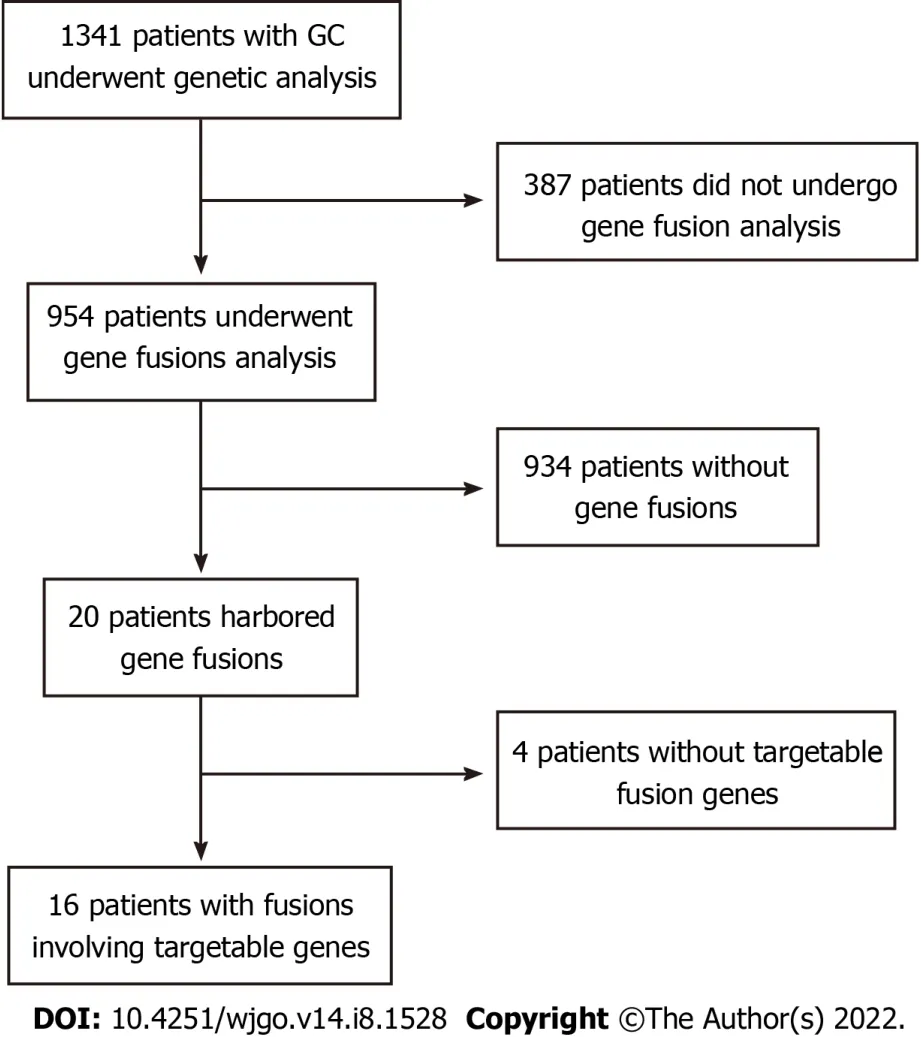
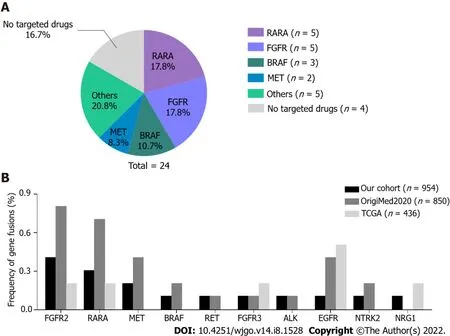
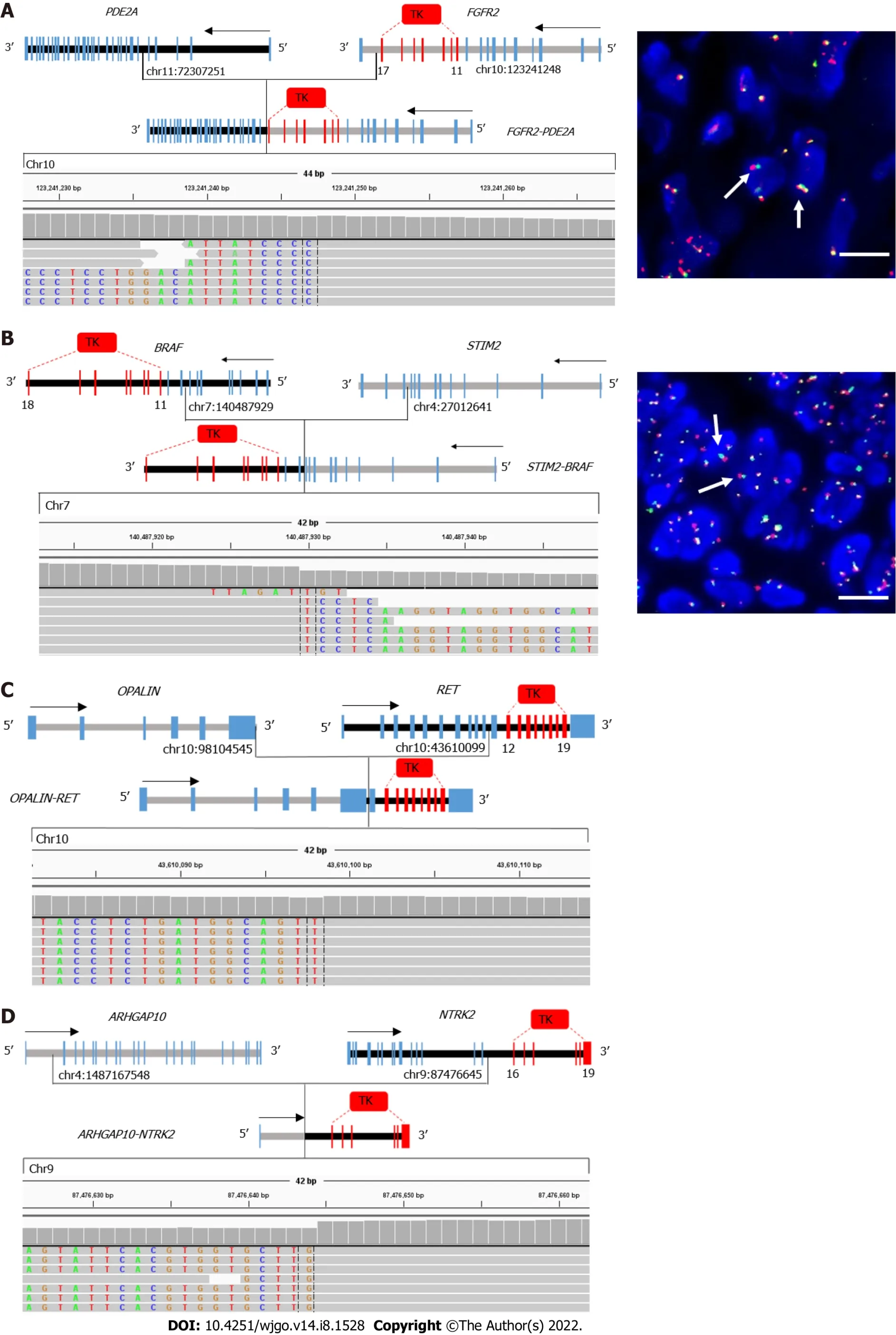
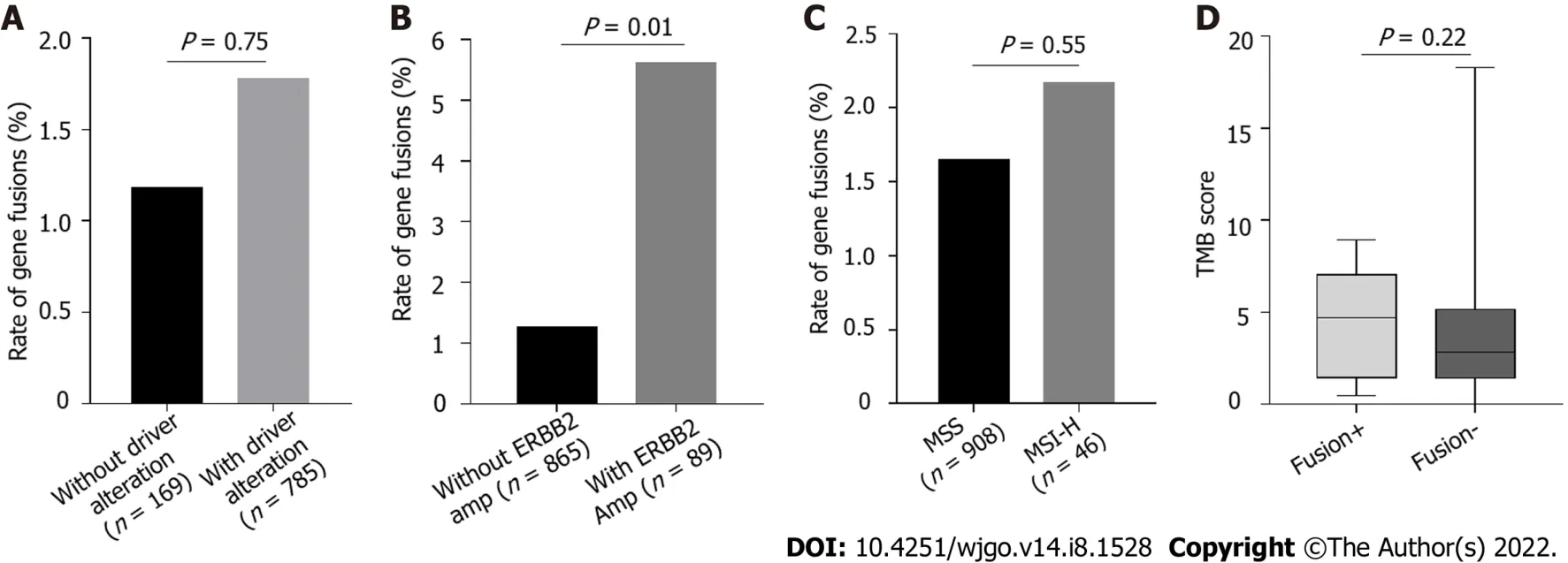
DlSCUSSlON
Structural gene rearrangements leading to gene fusions are common events that occur in solid tumors.Gene fusions have been considered oncogenic drivers in neoplasia for more than 30 years[30].Detection and characterization of gene fusions is important for clinical purposes[31].As the first large-scale study focusing on gene fusion events in Chinese patients with GC,we retrospectively analyzed 954 tumor specimens to identify fusions involving targetable genes and confirmed the occurrence of these fusions in GC.
In this study,16 of 954 patients harbored 20 fusions involving targetable genes,the majority of which had not been previously reported,including
,
,
and
.However,we did not find any significant differences between the Chinese GCcohort (our cohort and OrigiMed2020 cohort) and the TCGA cohort.Fusions in
,
,
,and
were detected in two Chinese cohorts but not in the TCGA cohort.This finding may have resulted from the small size of the TCGA cohort,which is prone to bias for gene fusions events because of the low occurrence rate in GC.A comparative study with a larger population is needed to identify differences in fusions involving targetable genes between races.
A major contribution of gene fusions to patients with tumor is the development of drugs that target fusion proteins encoded by these genes.The majority of advances in targeting gene fusions involve kinase domains that constitutively activate downstream signaling pathways[32].In this study,except
and
fusions,the 14 other fusions involving targetable genes included a receptor tyrosine kinase (RTK) gene,such as
,
,
,
,
,
,and
.Furthermore,most of all RTK gene fusions (13/14) completely retained the tyrosine kinase domain,which resulted in functional fusion proteins.We only verified the
rearrangement in patient 09 and the
rearrangement in patient 04 using FISH because of insufficient tumor specimens.These fusions were consistent with previously observed fusions[23]; however,only 1 out of 5
fusions contained exons 3-9,which encodes a DNA-binding and ligand-binding domain,which are required for
transcription factor activity.These results indicate that most patients with GC with fusions involving targetable genes may benefit from drugs that target fusions.However,patients in this retrospective study had not received targeted drug treatment; thus,we cannot determine whether they would have benefited from fusion-targeted drug therapy.
Interestingly,we also discovered 18 novel fusions with unreported partner genes or with an intergenic space.In other words,screening for known fusions in GC by FISH or polymerase chain reaction will likely miss most of the gene fusions that involve targetable genes.This is not conducive to patients with GC participating in clinical trials of fusion-targeted drugs in pan-cancer.Additionally,we found gene fusions enriched in patients with
amplification.We did not confirm all fusions using FISH because of limited tumor tissue samples,nor could we identify gene fusions enriched in distinct molecular subtypes of GC.Moreover,the efficacy of fusion-targeted drugs in GC remains to be further validated in clinical trials.Despite these limitations,for patients who fail standard therapy,NGS-based novel gene fusion detection may provide a new treatment strategy and facilitate participation into clinical trials involving targeted therapy.
CONCLUSlON
Liu ZH and Ma TH designed the study and reviewed the manuscript; Liu ZH,Zhu BW,Shi M analyzed the clinical and gene fusions data and wrote the manuscript; He XJ,Ma J,Liu ZC,and Tao HQ provided clinical advice; Yuan HL,Li W,Zhao DD,Wang BM,and Wang CY reviewed the manuscript and provided advice;All authors have read and approved the final manuscript.
ARTlCLE HlGHLlGHTS
Research background
With rapid advancements in oncogenomics,increasing attention has been focused on gene fusions in cancer.The Food and Drug Administration has approved several fusion-targeted drugs for the treatment of solid tumors,such as larotrectinib for NTRK fusion-positive cancers and Zenocutuzumab for NRG1 fusion-positive cancers.However,targetable gene fusions in Chinese patients with gastric cancer (GC) have not been well characterized.
Research motivation
Research objectives
To explore the types and proportion of targetable gene fusions in Chinese patients with GC and determine the distribution of patients with gene fusions among the molecular subtypes of GC.
Research methods
This was a multicenter retrospective study that evaluated patients with GC.A total of 954 tumor tissue samples from patients with GC who underwent gene fusion detection were included.Genetic alterations,including SNVs,indels,amplifications,and gene fusions,were analyzed.The enrichment of gene fusions in the molecular subtypes of GC was explored.
Research results
Twenty fusions involving targetable genes were detected.Among them,18 novel gene fusion events were previously not reported in other cancers.Owing to a limited number of tumor tissue samples,only BRAF and FGFR2 fusions were identified by fluorescence in situ hybridization.Additionally,we found that gene fusions were enriched in patients with ERBB2 amplification.
Ali Baba, who expected a dull, dismal5 place, was greatly surprised to find it large and well lighted, hollowed by the hand of man in the form of a vault6, which received the light from an opening in the ceiling
Research conclusions
Mutational profiling of the Onco PanScan panel was performed by Genetron Health (Beijing) Co.,Ltd.The coding regions of 825 cancer-related genes were analyzed.Genomic DNA was isolated from formalin-fixed paraffin-embedded (FFPE) tissue specimens with a minimum of 20% viable tumor nuclei.For sequencing,paired tumor and white blood cell DNA libraries were prepared using KAPA HyperPrep Kits (Roche,Germany).Libraries were quantified using Qubit fluorometer (Thermo Fisher Scientific,Waltham,MA,United States),and their quality was evaluated using Agilent 2100 Bioanalyzer(Agilent Technologies,Santa Clara,CA,United States).High-throughput sequencing was performed on Novaseq6000 platform (Illumina,United States).Paired-end reads from Illumina sequencing were processed using script bcl2fastq (v.2.17.1.14) and aligned against the human genome reference build,GRCh37,using Burrows-Wheeler Aligner (BWA,version 0.7.13).Duplicate removal,local realignment,and base quality recalibration were performed using PICARD (http://broadinstitute.github.io/picard/)and the Genome Analysis Toolkit.Variant calling was performed using an in-house developed pipeline.Variants identified as germline variants were excluded,while single nucleotide variants (SNVs) and indels with allelic fractions of more than 5% and supported by more than 4 unique reads,amplification with a fold-change greater than 2.5 in more than 25% of regions covered,and gene fusions supported by more than 3 unique reads were included.
The frog answered, I do not care for thy clothes, thy pearls and jewels, or thy golden crown, but if thou wilt love me and let me be thy companion and play-fellow, and sit by thee at thy little table, and eat off thy little golden plate, and drink out of thy little cup, and sleep in thy little bed -- if thou wilt promise me this I will go down below, and bring thee thy golden ball up again.
Research perspectives
A large study should be performed to further confirm the targetable gene fusions and identify whether gene fusions are enriched in distinct molecular subtypes of GC.
To investigate the incidence of gene fusions involving targetable genes in Chinese patients with GC and explore a potential treatment strategy for patients with GC.
As the first large-scale study focusing on gene fusion events in Chinese patients with GC,we determined the frequency (16/954) of targetable gene fusions,and the majority of these fusions,including
,
,
,
,
,and
,had not been previously described.These novel fusions completely retain a kinase domain.Additionally,we found gene fusions that were enriched in patients with
amplification.Gene fusion detection may aid in the development of novel treatment strategies for patients with GC.
This multicenter retrospective study included 1341 patients with GC admitted to Fujian Provincial Hospital (Fuzhou,China) and Zhejiang Provincial People’s Hospital (Hangzhou,China) between October 2015 and December 2021.The clinicopathological characteristics of the patients were retrieved from their medical records.Additionally,MSI status and tumor mutational burden (TMB) scores were extracted for statistical analysis.This study was approved by the Ethics Committee of the Fujian Provincial Hospital.
All study participants or their legal guardian provided informed written consent about personal and medical data collection prior to study enrolment.
All the authors report no relevant conflicts of interest for this article.
No additional data are available.
Then the lid sprang up to the right, and the princess came out, straight over him, and rushed round the church, howling and shrieking33 Sentry, where are you? Sentry, where are you? She went towards the altar, and right up to it, but there was no one there; then she screamed again,My father has set no sentry in, War and Pest will now begin
This article is an open-access article that was selected by an in-house editor and fully peer-reviewed by external reviewers.It is distributed in accordance with the Creative Commons Attribution NonCommercial (CC BYNC 4.0) license,which permits others to distribute,remix,adapt,build upon this work non-commercially,and license their derivative works on different terms,provided the original work is properly cited and the use is noncommercial.See: https://creativecommons.org/Licenses/by-nc/4.0/
China
Zhen-Hua Liu 0000-0002-1820-0292; Jie Ma 0000-0003-3755-996X; Tong-Hui Ma 0000-0002-5414-0522.
But she had only been there a very little time before a wandering butterfly brought a message from her to the Fairy, begging that she might be sent for as soon as possible, and before very long she was allowed to return
American Association for Cancer Research,No.1070947.
Gong ZM
Filipodia
Gong ZM
1 Sung H,Ferlay J,Siegel RL,Laversanne M,Soerjomataram I,Jemal A,Bray F.Global Cancer Statistics 2020:GLOBOCAN Estimates of Incidence and Mortality Worldwide for 36 Cancers in 185 Countries.
2021;71: 209-249 [PMID: 33538338 DOI: 10.3322/caac.21660]
2 Sexton RE,Al Hallak MN,Diab M,Azmi AS.Gastric cancer: a comprehensive review of current and future treatment strategies.
2020; 39: 1179-1203 [PMID: 32894370 DOI: 10.1007/s10555-020-09925-3]
3 Jin G,Lv J,Yang M,Wang M,Zhu M,Wang T,Yan C,Yu C,Ding Y,Li G,Ren C,Ni J,Zhang R,Guo Y,Bian Z,Zheng Y,Zhang N,Jiang Y,Chen J,Wang Y,Xu D,Zheng H,Yang L,Chen Y,Walters R,Millwood IY,Dai J,Ma H,Chen K,Chen Z,Hu Z,Wei Q,Shen H,Li L.Genetic risk,incident gastric cancer,and healthy lifestyle: a meta-analysis of genomewide association studies and prospective cohort study.
2020; 21: 1378-1386 [PMID: 33002439 DOI:10.1016/S1470-2045(20)30460-5]
4 Jemal A,Bray F,Center MM,Ferlay J,Ward E,Forman D.Global cancer statistics.
2011; 61: 69-90[PMID: 21296855 DOI: 10.3322/caac.20107]
5 Patel TH,Cecchini M.Targeted Therapies in Advanced Gastric Cancer.
2020; 21: 70 [PMID:32725377 DOI: 10.1007/s11864-020-00774-4]
6 Grillo F,Fassan M,Sarocchi F,Fiocca R,Mastracci L.HER2 heterogeneity in gastric/gastroesophageal cancers: From benchside to practice.
2016; 22: 5879-5887 [PMID: 27468182 DOI: 10.3748/wjg.v22.i26.5879]
7 Abrahao-Machado LF,Scapulatempo-Neto C.HER2 testing in gastric cancer: An update.
2016;22: 4619-4625 [PMID: 27217694 DOI: 10.3748/wjg.v22.i19.4619]
8 Rüschoff J,Hanna W,Bilous M,Hofmann M,Osamura RY,Penault-Llorca F,van de Vijver M,Viale G.HER2 testing in gastric cancer: a practical approach.
2012; 25: 637-650 [PMID: 22222640 DOI: 10.1038/modpathol.2011.198]
9 Bartley AN,Washington MK,Colasacco C,Ventura CB,Ismaila N,Benson AB 3rd,Carrato A,Gulley ML,Jain D,Kakar S,Mackay HJ,Streutker C,Tang L,Troxell M,Ajani JA.HER2 Testing and Clinical Decision Making in Gastroesophageal Adenocarcinoma: Guideline From the College of American Pathologists,American Society for Clinical Pathology,and the American Society of Clinical Oncology.
2017; 35: 446-464 [PMID: 28129524 DOI:10.1200/JCO.2016.69.4836]
10 Cancer Genome Atlas Research Network.Comprehensive molecular characterization of gastric adenocarcinoma.
2014; 513: 202-209 [PMID: 25079317 DOI: 10.1038/nature13480]
11 Cho J,Kang SY,Kim KM.MMR protein immunohistochemistry and microsatellite instability in gastric cancers.
2019; 51: 110-113 [PMID: 30497803 DOI: 10.1016/j.pathol.2018.09.057]
12 Scott LJ.Larotrectinib: First Global Approval.
2019; 79: 201-206 [PMID: 30635837 DOI:10.1007/s40265-018-1044-x]
13 Frampton JE.Entrectinib: A Review in NTRK+ Solid Tumours and ROS1+ NSCLC.
2021; 81: 697-708 [PMID:33871816 DOI: 10.1007/s40265-021-01503-3]
14 Soda M,Choi YL,Enomoto M,Takada S,Yamashita Y,Ishikawa S,Fujiwara S,Watanabe H,Kurashina K,Hatanaka H,Bando M,Ohno S,Ishikawa Y,Aburatani H,Niki T,Sohara Y,Sugiyama Y,Mano H.Identification of the transforming EML4-ALK fusion gene in non-small-cell lung cancer.
2007; 448: 561-566 [PMID: 17625570 DOI:10.1038/nature05945]
15 Roskoski R Jr.Anaplastic lymphoma kinase (ALK): structure,oncogenic activation,and pharmacological inhibition.
2013; 68: 68-94 [PMID: 23201355 DOI: 10.1016/j.phrs.2012.11.007]
16 Holla VR,Elamin YY,Bailey AM,Johnson AM,Litzenburger BC,Khotskaya YB,Sanchez NS,Zeng J,Shufean MA,Shaw KR,Mendelsohn J,Mills GB,Meric-Bernstam F,Simon GR.ALK: a tyrosine kinase target for cancer therapy.
2017; 3: a001115 [PMID: 28050598 DOI: 10.1101/mcs.a001115]
17 Kwak EL,Bang YJ,Camidge DR,Shaw AT,Solomon B,Maki RG,Ou SH,Dezube BJ,J?nne PA,Costa DB,Varella-Garcia M,Kim WH,Lynch TJ,Fidias P,Stubbs H,Engelman JA,Sequist LV,Tan W,Gandhi L,Mino-Kenudson M,Wei GC,Shreeve SM,Ratain MJ,Settleman J,Christensen JG,Haber DA,Wilner K,Salgia R,Shapiro GI,Clark JW,Iafrate AJ.Anaplastic lymphoma kinase inhibition in non-small-cell lung cancer.
2010; 363: 1693-1703 [PMID:20979469 DOI: 10.1056/NEJMoa1006448]
18 Camidge DR,Bang YJ,Kwak EL,Iafrate AJ,Varella-Garcia M,Fox SB,Riely GJ,Solomon B,Ou SH,Kim DW,Salgia R,Fidias P,Engelman JA,Gandhi L,J?nne PA,Costa DB,Shapiro GI,Lorusso P,Ruffner K,Stephenson P,Tang Y,Wilner K,Clark JW,Shaw AT.Activity and safety of crizotinib in patients with ALK-positive non-small-cell lung cancer:updated results from a phase 1 study.
2012; 13: 1011-1019 [PMID: 22954507 DOI:10.1016/S1470-2045(12)70344-3]
19 Wen Z,Xiong D,Zhang S,Liu J,Li B,Li R,Zhang H.Case Report:
: A Novel
Fusion in a Patient With Gastric Cancer.
2021; 11: 645370 [PMID: 33692962 DOI: 10.3389/fonc.2021.645370]
20 Stransky N,Cerami E,Schalm S,Kim JL,Lengauer C.The landscape of kinase fusions in cancer.
2014; 5:4846 [PMID: 25204415 DOI: 10.1038/ncomms5846]
21 Hoadley KA,Yau C,Hinoue T,Wolf DM,Lazar AJ,Drill E,Shen R,Taylor AM,Cherniack AD,Thorsson V,Akbani R,Bowlby R,Wong CK,Wiznerowicz M,Sanchez-Vega F,Robertson AG,Schneider BG,Lawrence MS,Noushmehr H,Malta TM; Cancer Genome Atlas Network,Stuart JM,Benz CC,Laird PW.Cell-of-Origin Patterns Dominate the Molecular Classification of 10,000 Tumors from 33 Types of Cancer.
2018; 173: 291-304.e6 [PMID: 29625048 DOI:10.1016/j.cell.2018.03.022]
22 De Braekeleer E,Douet-Guilbert N,De Braekeleer M.RARA fusion genes in acute promyelocytic leukemia: a review.
2014; 7: 347-357 [PMID: 24720386 DOI: 10.1586/17474086.2014.903794]
23 Fusco MJ,Saeed-Vafa D,Carballido EM,Boyle TA,Malafa M,Blue KL,Teer JK,Walko CM,McLeod HL,Hicks JK,Extermann M,Fleming JB,Knepper TC,Kim DW.Identification of Targetable Gene Fusions and Structural Rearrangements to Foster Precision Medicine in
Wild-Type Pancreatic Cancer.
2021; 5 [PMID:34250383 DOI: 10.1200/PO.20.00265]
24 Koivunen JP,Mermel C,Zejnullahu K,Murphy C,Lifshits E,Holmes AJ,Choi HG,Kim J,Chiang D,Thomas R,Lee J,Richards WG,Sugarbaker DJ,Ducko C,Lindeman N,Marcoux JP,Engelman JA,Gray NS,Lee C,Meyerson M,J?nne PA.EML4-ALK fusion gene and efficacy of an ALK kinase inhibitor in lung cancer.
2008; 14: 4275-4283[PMID: 18594010 DOI: 10.1158/1078-0432.CCR-08-0168]
25 Cantile M,Marra L,Franco R,Ascierto P,Liguori G,De Chiara A,Botti G.Molecular detection and targeting of EWSR1 fusion transcripts in soft tissue tumors.
2013; 30: 412 [PMID: 23329308 DOI: 10.1007/s12032-012-0412-8]
26 Zhu YC,Wang WX,Li XL,Xu CW,Chen G,Zhuang W,Lv T,Song Y.Identification of a Novel Icotinib-Sensitive EGFR-SEPTIN14 Fusion Variant in Lung Adenocarcinoma by Next-Generation Sequencing.
2019; 14:e181-e183 [PMID: 31345345 DOI: 10.1016/j.jtho.2019.03.031]
27 Chou A,Fraser T,Ahadi M,Fuchs T,Sioson L,Clarkson A,Sheen A,Singh N,Corless CL,Gill AJ.NTRK gene rearrangements are highly enriched in MLH1/PMS2 deficient,BRAF wild-type colorectal carcinomas-a study of 4569 cases.
2020; 33: 924-932 [PMID: 31792356 DOI: 10.1038/s41379-019-0417-3]
28 Wang Y,Xu Y,Wang X,Sun C,Guo Y,Shao G,Yang Z,Qiu S,Ma K.RET fusion in advanced non-small-cell lung cancer and response to cabozantinib: A case report.
2019; 98: e14120 [PMID: 30653139 DOI:10.1097/MD.0000000000014120]
29 Kobayashi M,Sakakibara T,Inoue A,Fukuhara T,Sasano H,Ichinose M,Nukiwa T.Effective enrichment strategy for EML4-ALK fusion gene screening in patients with non-small cell lung cancer.
2014; 52: 49-56 [PMID:24388371 DOI: 10.1016/j.resinv.2013.06.003]
30 Mertens F,Johansson B,Fioretos T,Mitelman F.The emerging complexity of gene fusions in cancer.
2015; 15: 371-381 [PMID: 25998716 DOI: 10.1038/nrc3947]
31 Mitelman F,Johansson B,Mertens F.The impact of translocations and gene fusions on cancer causation.
2007; 7: 233-245 [PMID: 17361217 DOI: 10.1038/nrc2091]
32 Schram AM,Chang MT,Jonsson P,Drilon A.Fusions in solid tumours: diagnostic strategies,targeted therapy,and acquired resistance.
2017; 14: 735-748 [PMID: 28857077 DOI: 10.1038/nrclinonc.2017.127]
 World Journal of Gastrointestinal Oncology2022年8期
World Journal of Gastrointestinal Oncology2022年8期
- World Journal of Gastrointestinal Oncology的其它文章
- Colitis and colorectal tumors should be further explored and differentiated
- Exosomes:Promising biomarkers and targets for cancer
- Acute or chronic inflammation role in gastrointestinal oncology
- Ewing sarcoma of the ileum with wide multiorgan metastases:A case report and review of literature
- RASSF1A methylation as a biomarker for detection of colorectal cancer and hepatocellular carcinoma
- Evaluation of the diagnostic value of serum-based proteomics for colorectal cancer
